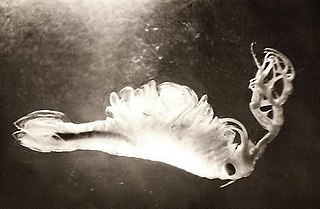
Branchiopoda is a class of crustaceans. It comprises fairy shrimp, clam shrimp, Diplostraca, Notostraca, the Devonian Lepidocaris and possibly the Cambrian Rehbachiella. They are mostly small, freshwater animals that feed on plankton and detritus.

Anostraca is one of the four orders of crustaceans in the class Branchiopoda; its members are referred to as fairy shrimp. They live in vernal pools and hypersaline lakes across the world, and they have even been found in deserts, ice-covered mountain lakes, and Antarctic ice. They are usually 6–25 mm (0.24–0.98 in) long. Most species have 20 body segments, bearing 11 pairs of leaf-like phyllopodia, and the body lacks a carapace. They swim "upside-down" and feed by filtering organic particles from the water or by scraping algae from surfaces, with the exception of Branchinecta gigas, or "giant fairy shrimp", which is itself a predator of other species of anostracans. They are an important food for many birds and fish, and some are cultured and harvested for use as fish food. There are 300 species spread across 8 families.

Branchinecta is a genus of fairy shrimp in family Branchinectidae. It includes around 50 species, found on all continents except Australia. Branchinecta gigas, the giant fairy shrimp, is the largest species in the order, with a length of up to 10 centimetres (4 in), and Branchinecta brushi lives at the highest altitude of any crustacean, at 5,930 metres (19,460 ft), a record it shares with the copepod Boeckella palustris. A new genus, Archaebranchinecta was established in 2011 for two species previously placed in Branchinecta.

Branchinella is a genus of crustaceans in the family Thamnocephalidae. This fairy shrimp genus is found across many parts of the world, but especially western Australia and southern Africa.

Chirocephalus is a genus of fairy shrimp in the family Chirocephalidae. It contains the following species:

Streptocephalus is a genus of fairy shrimp found in temporary waters in Africa, Australia, Eurasia, and Central and North America, following its ancient origin in Gondwana. It contains the following species:

Thamnocephalidae is a family of anostracan branchiopod crustaceans with wide distribution including Western Australia, Southern Africa and South America. It was originally described as a subfamily of Branchipodidae by Alpheus Spring Packard in 1883, and elevated to the rank of family by Simon in 1886. Six genera are recognised, in two subfamilies:

Tanymastigidae is a family of fairy shrimp. It contains two genera:

Branchipodidae is a family of fairy shrimp, one of eight in the order Anostraca. It contains 35 extant species in five extant genera:

Linderiella is a genus of fairy shrimp, previously placed in its own family, Linderiellidae, but now usually considered part of the Chirocephalidae. It comprises five species – Linderiella occidentalis and L. santarosae from California, L. africana from the Atlas Mountains in Morocco, L. massaliensis from southeastern France and L. baetica from southern Spain.
Linderiella africana is a species of fairy shrimp in the family Chirocephalidae. It is found in Africa.
Linderiella massaliensis is a species of fairy shrimp in the family Chirocephalidae. It is found in Europe and Northern Asia.
Branchinecta gaini is a species of fairy shrimp from Antarctica and Patagonia. It is the largest freshwater invertebrate in Antarctica, at 16 mm (0.63 in) long. It lives on bacteria and other organisms, surviving the winter as resting eggs.

Lepidocaris rhyniensis is an extinct species of crustacean. It is the only species known from the order Lipostraca, and is the only abundant animal in the Pragian-aged Rhynie chert deposits. It resembles modern Anostraca, to which it is probably closely related, although its relationships to other orders remain unclear. The body is 3 mm (0.12 in) long, with 23 body segments and 19 pairs of appendages, but no carapace. It occurred chiefly among charophytes, probably in alkaline temporary pools.
Parastreptocephalus is a subgenus of the fairy shrimp genus Streptocephalus, characterised by features of the male antennae and the tetrahedral shape of the eggs. It comprises six species:

Branchipodopsis is a genus of aquatic crustaceans, in the order Anostraca. It is one of several genera known as fairy shrimp. All described species are specialised for inhabiting ephemeral rock pools in situations such as mountains and deserts. Though the genus is most widely known from Africa, some occur in the middle east and adjoining regions.

Eubranchipus is a genus of brine shrimp and fairy shrimp in the family Chirocephalidae. There are about 16 described species in Eubranchipus.
Lynceus is a genus of clam shrimp in the family Lynceidae. There are about 13 described species in Lynceus.
Lynceidae is a family of clam shrimp in the order Laevicaudata. There are about 5 genera and more than 20 described species in Lynceidae.
Eubranchipus serratus, the ethologist fairy shrimp, is a species of branchiopod in the family Chirocephalidae. It is found in North America.













